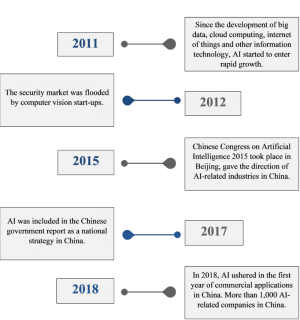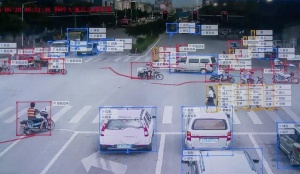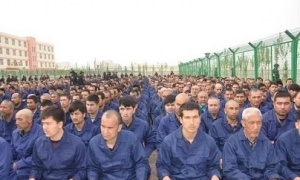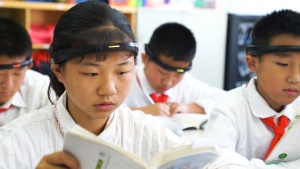Difference between revisions of "Artificial Intelligence in China"
| Line 85: | Line 85: | ||
To track everyone in the country, the Chinese government is using facial recognition cameras installed on streets and inside buildings to help police grab the identities of people wherever they travel, find out who they are meeting with, and identify who does and doesn’t belong to the Communist Party. By 2018, they had installed close to 200 million surveillance cameras across the country, which amounts to approximately one camera per seven citizens. <ref> https://www.nytimes.com/2018/07/08/business/china-surveillance-technology.html </ref> China has become the world’s biggest market for security and surveillance technology, with analysts estimating the country will have almost 300 million cameras installed by 2020. <ref name = chinasurveill"> https://www.nytimes.com/2018/07/08/business/china-surveillance-technology.html </ref> On top of that, the Chinese government has adopted surveillance drones, robot police, [https://en.wikipedia.org/wiki/Internet_censorship_in_China internet surveillance], and big data collection targeting online social media platforms to monitor its citizens, which has given the police and government authorities immense power to control people at the expense of personal privacy. <ref> https://www.nytimes.com/2019/12/17/technology/china-surveillance.html </ref> | To track everyone in the country, the Chinese government is using facial recognition cameras installed on streets and inside buildings to help police grab the identities of people wherever they travel, find out who they are meeting with, and identify who does and doesn’t belong to the Communist Party. By 2018, they had installed close to 200 million surveillance cameras across the country, which amounts to approximately one camera per seven citizens. <ref> https://www.nytimes.com/2018/07/08/business/china-surveillance-technology.html </ref> China has become the world’s biggest market for security and surveillance technology, with analysts estimating the country will have almost 300 million cameras installed by 2020. <ref name = chinasurveill"> https://www.nytimes.com/2018/07/08/business/china-surveillance-technology.html </ref> On top of that, the Chinese government has adopted surveillance drones, robot police, [https://en.wikipedia.org/wiki/Internet_censorship_in_China internet surveillance], and big data collection targeting online social media platforms to monitor its citizens, which has given the police and government authorities immense power to control people at the expense of personal privacy. <ref> https://www.nytimes.com/2019/12/17/technology/china-surveillance.html </ref> | ||
| + | [[File:Xinjiang_reeducation_camps.jpg|thumbnail|Xinjiang re-education camp]] | ||
====Monitoring Ethnic Minorities in Xinjiang==== | ====Monitoring Ethnic Minorities in Xinjiang==== | ||
| Line 124: | Line 125: | ||
'''4) Respect for Privacy''' | '''4) Respect for Privacy''' | ||
| − | + | Personal privacy should be respected and protected; privacy standards should be established for the collection, storage, processing, and use of personal information in all aspects of product development | |
'''5) Security and Controllability''' | '''5) Security and Controllability''' | ||
| − | + | The public should have the right to know what data is being shared and the right to choose what to share; AI development should be transparent and ways to supervise, manage, track, and monitor those systems should be developed | |
'''6) Shared Responsibility''' | '''6) Shared Responsibility''' | ||
| Line 136: | Line 137: | ||
'''7) Open Collaboration''' | '''7) Open Collaboration''' | ||
| − | + | Interdisciplinary and cross border collaboration is encouraged and interactions in the development and governance of AI are promoted among the general public, research institutions, educational institutions, social organizations, enterprises, government departments, and international organizations | |
'''8) Agile Governance''' | '''8) Agile Governance''' | ||
| − | + | Management and governance systems will be constantly updated and improved throughout the AI product and services life cycle; research of potential risks related to the AI will be done to ensure it will continuously enhance the well-being of humanity | |
===Beijing AI Principles=== | ===Beijing AI Principles=== | ||
Revision as of 23:45, 24 March 2020
In the 21st century, Artificial Intelligence(AI) has been a vital part of China's technology industry. It's being used across myriads of sectors including education, video games, military, automotive, healthcare, government, manufacturing, finance, cybersecurity, and art, among many more. It's also implemented in many applications including AI chatbots(such as Xiaoice), search engines(such as Baidu), drones, self-driving cars, and China's Social Credit System. The amount of applications and possible benefits is too numerous to list, but there have been many controversies surrounding these applications. AI has been a prevalent part of China's citizens day to day life with its mass surveillance systems installed throughout the country, which has raised many questions of privacy and the devaluation of humanity. In 2017, China's State Council issued a centralized national strategy to promote the development of AI, envisioning a future where it will aid in industrial transformation, better social governance, and maintaining social stability. [1] China plans to incorporate the technology in almost all industries to become a global superpower for AI by 2030. However, because AI is advancing so rapidly, people consider it to be a danger to humanity if it progresses without being subjected to rules and regulations. As a result, the government created an ethics board and the first official Governance Principles for the New Generation of Artificial Intelligence to ensure the responsible development of the technology. Many ethical issues still arise with AI and its governance in China today but it continues to help solve many challenging problems in computer science, software engineering, and operations research, influencing billions of lives. [2]
Contents
Early History of Science and Technology Policy in China
Criticism
In 1950s China, both the Chinese government and its scientists rejected the advancement of cybernetics, which according to Kolmogorov was science concerned with the study of systems of any nature which are capable of receiving, storing and processing information. Because China was faced with enormous damage from WWII at the time, it did not have the resources to focus on science and technology. Cybernetics was deemed as a bourgeois pseudoscience and many scientists rejected its influence. Then in the 1960s, political campaigns such as the Great Leap Forward and the Cultural Revolution led to steep economics declines, exiles of many intellectuals, and paralyzed education systems, which further led to the decline of technology and science advancement. The "Gang of Four", a powerful political faction in China, criticized scientific theories such as Einstein's theory of relativity, Weiner's cybernetics, and the Big Bang Theory, preventing people from indulging in scientific and technological research. [3]
Turning Point
However in the 1970s, after the Gang of Four lost its power and the Cultural Revolution ended, the year 1978 became a turning point for the development of science and technology in China. The People's Republic of China held the first National Science Conference that year in Beijing to encourage the development of scientific and technological research. Deng Xiaoping, the leader of the People's Republic of China at the time, stressed in his opening remarks that science and technology were productive forces, and the key to China's modernizations was the modernization of science and technology.[4] The first cybernetics and AI research project was proposed here as a result.
Recent History
Government Supports AI
China is catching up fast in the AI industry and one of its biggest reasons is its collaboration between the Chinese government, private sector, investors, and academia. With the government funding the industry through developing national AI research centers, adding university courses on AI, enforcing tax policies benefitting technology companies developing or adopting AI, and initiatives to attract more AI talent and projects, the government's top-down approach help propel China's goal to be an AI superpower. Moreover, the country's millions of online connected users and surveillance on its citizens establish the biggest consumer database that any institution can use to train its AI technologies. [5]
Research Papers
China is continuously investing in AI research domestically and globally - it has published the highest amount of AI research papers so far, but numbers show they’re cited significantly less than US and EU papers. Even so, China is investing in improving the quality of its AI research papers by pushing three initiatives: [6]
1) China’s New Generation AI Development Plan, which calls for China to have made significant breakthroughs in AI theory by 2025
2) The Chinese government has created research centers, including the Artificial Intelligence Research Center, which has more than 100 employees.
3) The Chinese Ministry of Industry and Information Technology plans to allocate $950 million RMB annually to fund strategic AI projects.
New Generation AI Development Plan
On July 20, 2017, the state council released an official Plan for the Development of New Generation Artificial Intelligence [7] - the first of its kind to address AI as a national strategy in China. It outlined goals to build a domestic AI industry worth 150 billion RMB in the next few years and become the leading AI power by 2030.
• By 2020, the government expects “its companies and research facilities to be at the same level as leading AI countries like the United States” and the technology to become an important driver for economic growth
• By 2025, there will be major breakthroughs for fundamental AI theories and China will become the world’s leading level for some sets of AI technologies. AI will be applied in most areas such as smart manufacturing, smart healthcare, smart cities, smart agriculture, and national defense
• By 2030, China will become the world’s leader and global center for all AI theories, technologies, and applications. AI will also be deeply integrated into most industries
As a result of this plan, more than 1000 AI companies in China pushed out its first commercial applications a year later and the State Council allocated 2.1 billion RMB on an AI industrial park in Mentougou district.
AI Applications in China
China has world-leading companies in computer vision, speech recognition and natural language processing, including SenseTime, Unisound, iFLYTEK, and Megvii, says Zheng Nanning, director of the Institute of Artificial Intelligence and Robotics at Xi’an Jiaotong University. [8] But this is only the tip of the iceberg when it comes to how AI is applied and utilized in China.
Crime and Traffic Safety
The largest algorithm provider in China as well as the fifth-largest AI platform, SenseTime developed a facial recognition system called DeepID that lets China's police departments analyze video footage to catch criminals, track car plates to support traffic management, recognize traffic incidents to alert authorities, and track driver's motions to identify if they are falling asleep behind the wheel among many other applications.
Education
Squirrel AI
Over 1 billion RMB was invested in AI education in 2019 and one of these companies was Squirrel AI Learning. It uses adaptive learning, an education technology that utilizes AI to understand what learning materials a student is struggling with, then respond in real-time providing them with individual support until they master the subject.[9] Currently, the company has opened over 1700 schools in more than 200 cities across China using this technology.
Facial Recognition in the Classroom
AI, brain wave trackers, and cameras are being installed in classrooms to enhance teaching methods and monitor students' attention levels. By using facial recognition technology, brain wave trackers, and a live platform for students to point out what they understand and don't understand in class, schools could design curriculum around the students' attention patterns, better assess attendance, improve student engagement and learning activities, proctor exams, and enable educators to measure the effectiveness of their teaching methods. Parents could also get live information about their children's learning patterns, attention levels, and engagement in class. [10]
Autonomous Vehicles
When China’s government declared in 2017 that being the global leader in autonomous technology was a national priority, technologies like AI, 5G wireless networks, robotics, and smart cities became a priority associated with it as well. [11] Since then, many companies have worked to create autonomous vehicles such as buses, cars, robo-taxis, and drones using AI.
Self-Driving Cars and Robotaxis
Among dozens of autonomous driving companies, Baidu, one of the biggest internet and AI companies in China, became the first to secure licenses in July 2019 to test self-driving cars in Beijing, China. Beijing was the first city in China to allow autonomous road tests and by the end of December 2019, the city has allowed over 150 roads totaling more than 500 kilometers, or 310 miles, in length to be used for these tests. [12]
Online Banking
Social Credit System
Controversies and Ethics
Mass Surveillance
To track everyone in the country, the Chinese government is using facial recognition cameras installed on streets and inside buildings to help police grab the identities of people wherever they travel, find out who they are meeting with, and identify who does and doesn’t belong to the Communist Party. By 2018, they had installed close to 200 million surveillance cameras across the country, which amounts to approximately one camera per seven citizens. [13] China has become the world’s biggest market for security and surveillance technology, with analysts estimating the country will have almost 300 million cameras installed by 2020. [14] On top of that, the Chinese government has adopted surveillance drones, robot police, internet surveillance, and big data collection targeting online social media platforms to monitor its citizens, which has given the police and government authorities immense power to control people at the expense of personal privacy. [15]
Monitoring Ethnic Minorities in Xinjiang
In Xinjiang, its residents especially those from the Ughyer ethnic group are strictly monitored by surveillance apps and facial recognition cameras, ensuring they do not practice certain religious acts. The identities collected by the cameras are matched with individual profiles that include data about their biometrics, such as DNA samples and voice samples, and the people are algorithmically rated on a level of trustworthiness based on their profiles. [16] This brings up many issues as people could not opt-out of being surveilled, losing their privacy and ability to express their cultural identity. Many were arrested as a result of practicing their religion.
Predictive Policing and Re-education Camps
Since 2017, the government has set up re-education camps and an AI system that the government claims can predict individuals prone to "terrorism" and detect those in need of re-education [17], forcing ethnic minorities in China such as Uyghurs, Kazakhs, and Kyrgyz to comply. [18] [19] People were tortured and forced to undergo psychological indoctrination in the camps- like studying Communist propaganda, learning Mandarin Chinese, as well as praising the Chinese government - causing many human rights violations. [20]
Privacy in Education
With facial recognition data about each student in the classroom, students and their families are worried about what data points are being shared with their future schools and universities. Specifically, what if data about how focused each student was in their class gets shared with future schools and universities, damaging their chances of getting their dream education? This raises questions on how privacy has been an ongoing issue with AI as not all companies are transparent with what data they're collecting and sharing and what's not.
Face-Swapping in Online Payments
Zao, a face-swapping technology, first intended for users to swap their faces with friends and family for fun later posed a security threat to many of China's facial recognition payment systems as users could pose as other users to use their bank cards. [21]
Military Drones
Since 2019, China's military contractors have started to sell autonomous killer drones to customers in the Middle East. One company, called Ziyan is marketing its Blowfish A3 - an autonomous helicopter drone armed with a machine gun - to the governments of Pakistan and Saudi Arabia, signaling a future of an AI arms race, despite not aligning with values and principles from China's ethics board and AI governance principles. [22]
AI Governance Principles in China
Governance Principles for the New Generation of Artificial Intelligence
Many AI technologies and applications were developed as a result of the national strategy but an ethics board to govern the rapid development was still not created yet. On June 17, 2019, China’s Ministry of Science and Technology published the first official Governance Principles for the New Generation of Artificial Intelligence after several rounds of discussions with the Ministry’s New AI Governance Expert Committee. They proposed eight principles to ensure the development of responsible AI: [23]
1) Harmony and friendship
AI must align with society’s values and ethics; misuses and abuses must be prevented and prohibited
2) Fairness and justice
AI must protect the interest of all stakeholders and promote equal opportunities; prejudice and bias must be eliminated in data acquisition, algorithm design, product research, technology development, and the application itself
3) Inclusiveness and sharing
AI must aim to enhance the well-being of humanity; AI education must be strengthened and accessible to disadvantaged people and industries; data and platform monopolies must be prevented and open cooperation is encouraged
4) Respect for Privacy
Personal privacy should be respected and protected; privacy standards should be established for the collection, storage, processing, and use of personal information in all aspects of product development
5) Security and Controllability
The public should have the right to know what data is being shared and the right to choose what to share; AI development should be transparent and ways to supervise, manage, track, and monitor those systems should be developed
6) Shared Responsibility
AI developers, users, and all stakeholders have the shared responsibility to respect laws, ethics, and norms; an accountability system will be developed to assess the role of each
7) Open Collaboration
Interdisciplinary and cross border collaboration is encouraged and interactions in the development and governance of AI are promoted among the general public, research institutions, educational institutions, social organizations, enterprises, government departments, and international organizations
8) Agile Governance
Management and governance systems will be constantly updated and improved throughout the AI product and services life cycle; research of potential risks related to the AI will be done to ensure it will continuously enhance the well-being of humanity
Beijing AI Principles
In May 2019, the Beijing Academy of AI (BAAI), Peking University, Tsinghua University, Institute of Automation and Institute of Computing Technology in Chinese Academy of Sciences, and an AI industrial league involving firms like Baidu, Alibaba and Tencent, released the Beijing AI Principles calling for the “the construction of a human community with a shared future, and the realization of beneficial AI for humankind and nature.” [24]
The Principles are separated into three sections:
1) Research and Development
AI should be designed and developed to do good, serve humanity, be responsible, be secure and be able to control risks, be ethical, diverse and inclusive, as well as be an open platform for sharing and promoting equal opportunities. [25]
2) Use
AI should be used wisely and properly such that the users have the knowledge to operate the systems according to its design, avoiding misuse and abuse. Users should be informed about the technology's implications and be able to consent to AI's impact on their rights and interests. Stakeholders should be trained to adapt to the implications of AI psychologically, emotionally, and technically. [25]
3) Governance
AI should optimize employment, promote harmony and cooperation domestically and internationally to avoid a malicious AI race, and be adaptable to new rules and regulations. AI principles, policies, and regulations should actively adjust to the development of AI and continuous research on the potential risks of AI should be encouraged. [25]
Overall, these principles focus on benefitting all of humanity and the environment; serving human values such as privacy, dignity, freedom, autonomy, and rights; continuous focus on AI safety and security; inclusivity; openness; supporting international cooperation and avoiding a “malicious AI race”; and long-term planning for more advanced AI systems, among others. [24]
References
- ↑ https://na-production.s3.amazonaws.com/documents/translation-fulltext-8.1.17.pdf
- ↑ https://en.wikipedia.org/wiki/Artificial_intelligence
- ↑ http://wangjieshu.com/2018/10/17/history_of_ai_in_china/
- ↑ https://www.chinadaily.com.cn/china/19thcpcnationalcongress/2011-03/18/content_29715461.htm)
- ↑ https://emerj.com/ai-market-research/ai-in-china-recent-history-strengths-and-weaknesses-of-the-ecosystem/
- ↑ https://daxueconsulting.com/history-china-artificial-intelligence/
- ↑ http://chinainnovationfunding.eu/dt_testimonials/state-councils-plan-for-the-development-of-new-generation-artificial-intelligence/
- ↑ https://www.nature.com/articles/d41586-019-02360-7
- ↑ https://squirrelai.com/
- ↑ https://digitaledition.chicagotribune.com/tribune/article_popover.aspx?guid=11858e27-1f9d-434c-b53c-ab397b25e732
- ↑ https://innovator.news/chinas-drive-to-dominate-autonomous-cars-736f4a4d66bf
- ↑ https://venturebeat.com/2019/12/31/baidu-secures-licenses-to-test-self-driving-cars-in-beijing/
- ↑ https://www.nytimes.com/2018/07/08/business/china-surveillance-technology.html
- ↑ https://www.nytimes.com/2018/07/08/business/china-surveillance-technology.html
- ↑ https://www.nytimes.com/2019/12/17/technology/china-surveillance.html
- ↑ author., Wang, Maya. "Eradicating ideological viruses": China's campaign of repression against Xinjiang's Muslims. OCLC 1052124054
- ↑ https://www.pbs.org/wgbh/frontline/article/how-chinas-government-is-using-ai-on-its-uighur-muslim-population/
- ↑ https://www.irishtimes.com/news/world/asia-pacific/rights-groups-criticise-sharp-rise-in-arrests-in-china-s-xinjiang-province-1.3577158
- ↑ https://www.vox.com/2018/10/24/18018282/china-reeducation-camps-uighur-muslims
- ↑ https://www.vox.com/2018/10/24/18018282/china-reeducation-camps-uighur-muslims
- ↑ https://www.cnbc.com/2019/09/06/ai-worries-about-the-dangers-of-facial-recognition-growing-in-china.html
- ↑ https://www.defenseone.com/technology/2019/11/secdef-china-exporting-killer-robots-mideast/161100/
- ↑ http://chinainnovationfunding.eu/dt_testimonials/publication-of-the-new-generation-ai-governance-principles-developing-responsible-ai/
- ↑ 24.0 24.1 https://futureoflife.org/ai-policy-china
- ↑ 25.0 25.1 25.2 https://www.baai.ac.cn/blog/beijing-ai-principles




